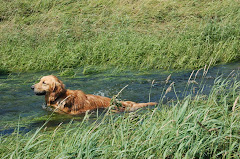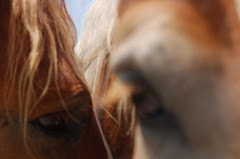CBC and Blood Chemistry Analyzer
Unlike most human physicians, we are able to perform a CBC (complete blood count) and chemistry panel (bloodwork) in the clinic while you wait with your animal. The CBC gives us a count of the red blood cells, white blood cells, hemoglobin and platelets. The chemistry panel is made up of 12-16 individual tests which assess internal organ function, endocrine function and electrolytes. These tests aid in our diagnosis when a pet or horse is sick or injured. We can have the results of a CBC and chemistry within 30-45 minutes of drawing blood. Below is a picture of our CBC and chemistry unit. 

Incubator for Culture Samples
This piece of equipment shown below is an incubator. On the counter in front of the incubator are culture plates.  This is used to perform a culture on a sample taken from an animal. The purpose of a culture is to identify the actual organism causing an infection. For the most part, a culture is taken with a sterile swab....for instance, a swab is taken of an infected ear. The swab is then plated or rubbed on the special plates which contain media to "grow" the organism causing the infection. The plates are placed in the incubator which is kept at 98 degrees. Usually, the infection is bacterial in origin but we can also identify yeast or fungal infections. The plates are then viewed at 24 and 48 hours. This photo shows a positive culture. Small white colonies of bacteria are seen growing on the blood agar (red) side and small bluish colonies are seen on the MacConkey agar (clear) side.
This is used to perform a culture on a sample taken from an animal. The purpose of a culture is to identify the actual organism causing an infection. For the most part, a culture is taken with a sterile swab....for instance, a swab is taken of an infected ear. The swab is then plated or rubbed on the special plates which contain media to "grow" the organism causing the infection. The plates are placed in the incubator which is kept at 98 degrees. Usually, the infection is bacterial in origin but we can also identify yeast or fungal infections. The plates are then viewed at 24 and 48 hours. This photo shows a positive culture. Small white colonies of bacteria are seen growing on the blood agar (red) side and small bluish colonies are seen on the MacConkey agar (clear) side.  These clusters of bacteria or fungus are then transferred to a sensitivity plate. Small discs impregnated with different antibiotics are added to the plate. This photo show the sensitivity plate with antibiotic impregnated discs.
These clusters of bacteria or fungus are then transferred to a sensitivity plate. Small discs impregnated with different antibiotics are added to the plate. This photo show the sensitivity plate with antibiotic impregnated discs.  If the infection or growth fails to grow around a certain antibiotic disc, a clear halo is seen surrounding the disc and the infection is said to be "sensitive" to that particular antibiotic......meaning that antibiotic can be used to treat the infection. If the infection continues to grow despite the antibiotic disc, the infection is said to be "resistant" to that antibiotic.....meaning that antibiotic should not be used to treat the infection. Areas that we typically culture are ears, skin, urine, abscesses and mare's uteri.
If the infection or growth fails to grow around a certain antibiotic disc, a clear halo is seen surrounding the disc and the infection is said to be "sensitive" to that particular antibiotic......meaning that antibiotic can be used to treat the infection. If the infection continues to grow despite the antibiotic disc, the infection is said to be "resistant" to that antibiotic.....meaning that antibiotic should not be used to treat the infection. Areas that we typically culture are ears, skin, urine, abscesses and mare's uteri.

 This is used to perform a culture on a sample taken from an animal. The purpose of a culture is to identify the actual organism causing an infection. For the most part, a culture is taken with a sterile swab....for instance, a swab is taken of an infected ear. The swab is then plated or rubbed on the special plates which contain media to "grow" the organism causing the infection. The plates are placed in the incubator which is kept at 98 degrees. Usually, the infection is bacterial in origin but we can also identify yeast or fungal infections. The plates are then viewed at 24 and 48 hours. This photo shows a positive culture. Small white colonies of bacteria are seen growing on the blood agar (red) side and small bluish colonies are seen on the MacConkey agar (clear) side.
This is used to perform a culture on a sample taken from an animal. The purpose of a culture is to identify the actual organism causing an infection. For the most part, a culture is taken with a sterile swab....for instance, a swab is taken of an infected ear. The swab is then plated or rubbed on the special plates which contain media to "grow" the organism causing the infection. The plates are placed in the incubator which is kept at 98 degrees. Usually, the infection is bacterial in origin but we can also identify yeast or fungal infections. The plates are then viewed at 24 and 48 hours. This photo shows a positive culture. Small white colonies of bacteria are seen growing on the blood agar (red) side and small bluish colonies are seen on the MacConkey agar (clear) side.  These clusters of bacteria or fungus are then transferred to a sensitivity plate. Small discs impregnated with different antibiotics are added to the plate. This photo show the sensitivity plate with antibiotic impregnated discs.
These clusters of bacteria or fungus are then transferred to a sensitivity plate. Small discs impregnated with different antibiotics are added to the plate. This photo show the sensitivity plate with antibiotic impregnated discs.  If the infection or growth fails to grow around a certain antibiotic disc, a clear halo is seen surrounding the disc and the infection is said to be "sensitive" to that particular antibiotic......meaning that antibiotic can be used to treat the infection. If the infection continues to grow despite the antibiotic disc, the infection is said to be "resistant" to that antibiotic.....meaning that antibiotic should not be used to treat the infection. Areas that we typically culture are ears, skin, urine, abscesses and mare's uteri.
If the infection or growth fails to grow around a certain antibiotic disc, a clear halo is seen surrounding the disc and the infection is said to be "sensitive" to that particular antibiotic......meaning that antibiotic can be used to treat the infection. If the infection continues to grow despite the antibiotic disc, the infection is said to be "resistant" to that antibiotic.....meaning that antibiotic should not be used to treat the infection. Areas that we typically culture are ears, skin, urine, abscesses and mare's uteri.Sugar Refractometer for Measuring Colostral Quality
The picture below is one of my favorite pieces of equipment. It is actually a sugar refractometer used to measure the amount of sugar in the juice of grapes when making wine. And while I do enjoy a glass of wine, we have not started a vineyard at the Arthur Veterinary Clinic. Instead, we use the refractometer to measure the quality of a mare's colostrum. Just like in other species, a mare's first milk or colostrum is full of antibodies which protect the newborn foal from infection. It is important to know the concentration of antibodies or IgG in the colostrum before the newborn foal nurses. If the colostral quality is poor or low, then the foal can be supplemented either orally, with high quality frozen colostrum or intravenously, with frozen plasma. To perform this test, a small amount of colostrum is milked from the mare before the foal nurses and placed on the refractometer. The refractometer is held up to the light and the reading is taken through the eyepiece. This percentage is then converted to the IgG concentration using the conversion chart pictured below. We like for the colostral reading to be >25% even though 20-30% is adequate. We supplement foals when the concentration is <20%.>30%. We freeze this high quality colostrum to supplement foals whose mother's have poor colostrum. This high quality frozen colostrum becomes like gold during the foaling season when frozen colostrum is in short supply. The best colostrum we have tested scored 48%!! This colostrum was chocked full of antibodies!!

Good Old Centrifuge-Our Workhorse!!!
I thought I'd include a picture of a centrifuge which is used to "spin down" samples of blood. Whether we are performing blood tests immediately, in the clinic, or sending a blood sample to an outside laboratory, most of the time the blood needs to be "spun down". What this means it the serum or plasma, depending on the the test, must be separated from the red blood cells. Most bloodwork is performed on serum or plasma. Blood samples are collected in blood tubes or vials. These tubes are placed in a centrifuge and spun at a very high rate of speed. The centrifugal force separates or pulls the red blood cells from the serum or plasma, leaving the serum or plasma setting on the top which can be easily removed with a pipette and submitted for testing. We use this centrifuge many times a day. I have actually had this centrifuge since before I started my practice in 1989!!.....I bought it in 1988 when I practiced out of my house. It has had to be repaired a couple of times but for the most part has been a real workhorse. If it ever goes kapute for good, I'll have to have a "parting ceremony" for it!!
 These diagnostic tests I have described are used almost daily at the Arthur Veterinary Clinic. We perform many other diagnostic tests and procedures both for preventative veterinary medicine and for diagnosis of disease, illness and injury. And what we do not perform in house, we send to different outside laboratories across the US. Hopefully, I have educated you about diagnostic tests. Also, I hope you are beginning to realize that veterinary medicine uses highly advanced and sophisticated supplies and equipment to diagnose, treat and prevent disease and illness in animals. And we, as veterinarians, do this for the health and well-being of the animals we see and love.
These diagnostic tests I have described are used almost daily at the Arthur Veterinary Clinic. We perform many other diagnostic tests and procedures both for preventative veterinary medicine and for diagnosis of disease, illness and injury. And what we do not perform in house, we send to different outside laboratories across the US. Hopefully, I have educated you about diagnostic tests. Also, I hope you are beginning to realize that veterinary medicine uses highly advanced and sophisticated supplies and equipment to diagnose, treat and prevent disease and illness in animals. And we, as veterinarians, do this for the health and well-being of the animals we see and love.
 These diagnostic tests I have described are used almost daily at the Arthur Veterinary Clinic. We perform many other diagnostic tests and procedures both for preventative veterinary medicine and for diagnosis of disease, illness and injury. And what we do not perform in house, we send to different outside laboratories across the US. Hopefully, I have educated you about diagnostic tests. Also, I hope you are beginning to realize that veterinary medicine uses highly advanced and sophisticated supplies and equipment to diagnose, treat and prevent disease and illness in animals. And we, as veterinarians, do this for the health and well-being of the animals we see and love.
These diagnostic tests I have described are used almost daily at the Arthur Veterinary Clinic. We perform many other diagnostic tests and procedures both for preventative veterinary medicine and for diagnosis of disease, illness and injury. And what we do not perform in house, we send to different outside laboratories across the US. Hopefully, I have educated you about diagnostic tests. Also, I hope you are beginning to realize that veterinary medicine uses highly advanced and sophisticated supplies and equipment to diagnose, treat and prevent disease and illness in animals. And we, as veterinarians, do this for the health and well-being of the animals we see and love. 









No comments:
Post a Comment